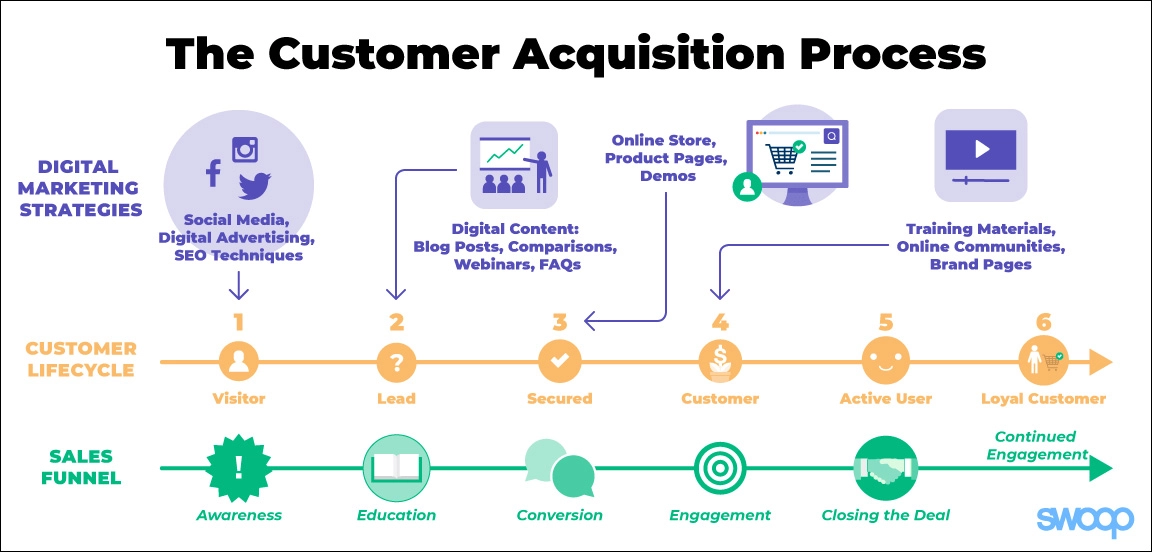
Why Customer Acquisition Cost Matters?
Customer acquisition cost by industry 2018 is particularly relevant for companies and investors. In the case of investors, it is a great way to assess the business potential of an emerging company and the innovative products or services it offers. The ability to make a profit is gauged by calculating the difference between the amount that customers would pay and the cost of acquiring that many customers.
By nature, entrepreneurs are born optimists and convinced about the success of what their company offers. In reality, there are only a handful of such B2C companies that manage to create a profitable and thriving business. The aim of early stage companies should be to monetize customers at a higher rate, as compared to the cost of gaining them.
The customer acquisition cost google analytics is also relevant to a marketing or operations department as they use it to enhance the returns for advertising expenditure. When the financial investment for acquiring customers reduces, the profitability of the company and its value is on the rise.
Simply put, a focus on robust customer acquisition strategies leads to an increase in customers who will bring the most revenue over the longest time period.

Figure:1 Customer Acquisition Strategy
Engagement Versus Cost
A Nielsen Total Audience Report from 2018 found that an average American engages with media for an estimated 11 hours in a day. However, they are yet to face information overload with the sheer magnitude of content shared. With such a perplexing array of options to choose from and content to explore, it’s not surprising that your content might be getting lost in the crowd.
An integrated marketing approach is necessary to compete with fast growing companies and sustain a healthy engagement with target audiences. Keep in mind that recent studies have observed the big impact customer retention can have on the overall valuation and viability of the company, i.e. even a 5% increase can lead to higher revenues by 25% to 95%.
In order to reap the benefits from a lower CAC, it’s important that your content marketing strategy is streamlined in order to maintain interest among audiences. It’s no longer enough to have a few standard blog posts and testimonials from generic profiles. The first step to revamping and upgrading the content is to track down relevant data — big data customer acquisition — for better insights.
Where Does Intent Data Come In?
B2B purchase intent data (intent data) is getting a lot of hype in the marketing world today. Assessing this buyer intent data is a central component to tackling content stagnation and cutting down the costs associated with acquiring new customers. B2B Lead generation is tough, and intricately linked to a successful content marketing strategy that intuitively learns the characteristics of potential networks, and enhances marketing outcomes.
Here are a few ways collecting intent data will help:
- Deeper understanding of what works.
It’s common for marketing campaigns to be created by teams that approximate the kind of messaging that will resonate best with a client base. Sometimes, this can lead to errors and steep acquisition costs. Intent data is much more detailed than a conventional keyword search or an analysis of consumer feedback. You can tap into patterns in the behaviour of your high value customers and track what they are most interested in, the type of content they engage with and what their favourite aspects are. Prolonged monitoring can give you the perfect idea regarding how to develop content that is best suited to their most preferred choices.
- Identifying influencer opportunities.
Instead of wasting valuable financial resources due to incorrect targeting, think out of the box by using intent data to see which influencers or digital platforms will expand your access to target audiences. Exploring other alternatives such as influencer marketing will prove to be more effective in bringing the numbers, than traditional methods such as sponsored content or online articles from guest bloggers. Intent data can help you narrow down opportunities that are most likely to deliver great results. Then, once the marketing strategy is established, you can move on to optimize other facets like the number of click-throughs or branding.


- Embracing impactful advertising.
Day by day, it’s becoming tougher for advertising and marketing teams to operate without planning a budget for paid advertising and outreach. Organic search traffic just isn’t cutting it in this competitive market and fails to make much of an impact. However, it’s not enough to simply increase your spending for paid content marketing without undertaking an extensive assessment of the strategy involved or the channels utilized.
Some mediums might be more effective for your target audience than others, based on the kind of industry and the product or service you provide. Buyer intent data makes the entire process easier, by letting you know the reach and effectiveness of one channel versus another. You can therefore gain a better understanding of what kind of content should be presented in front of a certain group of customers, to increase profits and reduce CAC.
Final Thoughts
To identify trends in the market and narrow down the ideal audience, it’s good to distinguish between the types of buyer intent data you need for the best results. In this case, collaborating with a reliable and trustworthy intent data provider might give you access to actionable findings that take you through every buyer’s journey. For instance, first party data can be valuable but it doesn’t give you a broader view of audience traits apart from your digital properties. On the other hand, if you supplement it with third part intent data, the combined approach may help you better understand any lingering gaps in content delivery and give you certain insights that will tip the scales, ultimately bringing down the overall CAC.
Our blog
Latest blog posts
Tool and strategies modern teams need to help their companies grow.

The 95/5 rule in B2B marketing shows that while only 5% of buyers are ready to purcha...

Running a business comes with its own set of challenges, especially when it comes to ...

AI is surely a futuristic concept but it evolves today, particularly in sales and mar...







